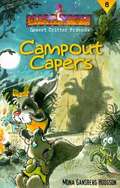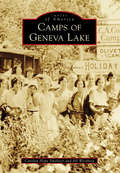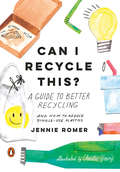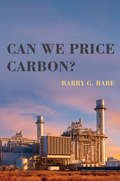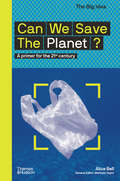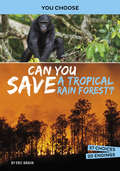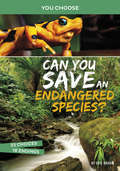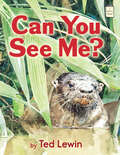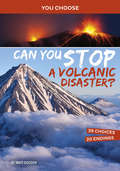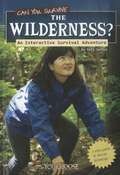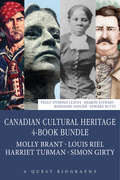- Table View
- List View
Campout Capers (Desert Critter Friends #8)
by Mona Gansberg HodgsonBack cover: Campout Capers Value: trust The desert critters are going on a campout. Everyone is excited . . . except Jill the ground squirrel. It is a nighttime campout and Jill doesn't stay awake at night like some of the other desert critters. She is afraid of what might happen in the dark. Will Jill be able to go to the campout without being fearful? Can she learn to trust her friends? Learn how the desert critters take care of each other at the campout. A lot of desert fun is waiting for you in this book! Kids love every Desert Critter Friends story! Each book uses beginning-reader vocabulary and short sentences to help kids develop reading skills and learn values. Children's Reader Level: Grade 2 Interest level: Ages 4-7
Camps of Geneva Lake (Images of America)
by Carolyn Hope Smeltzer Jill WestbergGeneva Lake camps provided education, activities, spirituality, and community in a healthy environment away from the city. The first sites were located on the western shores of Geneva Lake, with Camp Collie established in 1874; seventeen more followed. Although most camps were spiritually based, they differed in what they offered and who they served. People attending the camps came from all income levels and many cultures. Adult- and family-oriented camps provided a setting for vacations or conferences, and children's camps prided themselves on fostering responsibility and solid values. Images of America: Camps of Geneva Lake highlights 18 camps in the days of woolen bathing costumes, steam yachts, and platform tents.
Can Cities, States and Regions Save Our Planet?: Transatlantic Perspectives on Multilevel Climate Governance (Energy, Climate and the Environment)
by Arnault BarichellaThis book examines the potential for cities, states and regions to take decisive action on climate change at the local level. Local action constitutes an essential component of global efforts to keep temperatures below the 2°C Paris Agreement threshold. Focusing on three green municipal leaders - New York, Boston and Paris - this volume examines their multilevel interactions with higher governance echelons in the United States and France. Even though these countries are located on different continents, similar patterns emerge on both sides of the Atlantic. This book explores the key role of municipalities and sub-state entities in shaping the climate policy agenda vis-à-vis national governments in the US and France. It argues that inadequate articulation of multilevel governance may jeopardize efforts to limit global temperature increase below the 2°C threshold by the end of the century.
Can Fixing Dinner Fix the Planet? (Johns Hopkins Wavelengths)
by Jessica FanzoHow can consumers, nations, and international organizations work together to improve food systems before our planet loses its ability to sustain itself and its people?Do we have the right to eat wrongly?As the world's agricultural, environmental, and nutritional needs intersect—and often collide—how can consumers, nations, and international organizations work together to reverse the damage by changing how we make, distribute, and purchase food? Can such changes in practice and policy reverse the trajectories of the biggest global crises impacting our world: the burden of chronic diseases, the consequences of climate change, and the systemic economic and social inequities that exist within and among nations?Can Fixing Dinner Fix the Planet? is a clarion call for both individual consumers and those who shape our planet's food and environmental policies that:• describes the often destructive path that foods take from farms and seas through their processing, distribution, marketing, purchasing and waste management sites• explores the complex web of factors impacting our ability to simultaneously meet nutritional needs, sustain biodiversity and protect the environment• raises readers' food and environmental literacy through an engaging narrative about Fanzo's research on five continents along with the work of other inspiring global experts who are providing solutions to these crises• empowers readers to contribute to immediate and long-term changes by informing their decisions in restaurants, grocery stores, farmers markets, and kitchens
Can I Recycle This?: A Guide to Better Recycling and How to Reduce Single-Use Plastics
by Jennie Romer&“If you&’ve ever been perplexed by the byzantine rules of recycling, you&’re not alone…you&’ll want to read Can I Recycle This?... An extensive look at what you can and cannot chuck into your blue bin.&” —The Washington PostThe first illustrated guidebook that answers the age-old question: Can I Recycle This?Since the dawn of the recycling system, men and women the world over have stood by their bins, holding an everyday object, wondering, "can I recycle this?" This simple question reaches into our concern for the environment, the care we take to keep our homes and our communities clean, and how we interact with our local government. Recycling rules seem to differ in every municipality, with exceptions and caveats at every turn, leaving the average American scratching her head at the simple act of throwing something away. Taking readers on a quick but informative tour of how recycling actually works (setting aside the propaganda we were all taught as kids), Can I Recycle This gives straightforward answers to whether dozens of common household objects can or cannot be recycled, as well as the information you need to make that decision for anything else you encounter. Jennie Romer has been working for years to help cities and states across America better deal with the waste we produce, helping draft meaningful legislation to help communities better process their waste and produce less of it in the first place. She has distilled her years of experience into this non-judgmental, easy-to-use guide that will change the way you think about what you throw away and how you do it.
Can We Feed The Future Before The Well Runs Dry?
by David Farrell PhD D.Rur.Sci.Mankind is at a crossroads. We need to increase food production by 70% by 2050 in the face of climate change, increased water and fertiliser demand, declining arable land area, environmental degradation and an affluent and rapidly-growing population with inequality rising quickly. But what about the one billion now living in poverty; many with insufficient money to buy food and go to bed hungry every night yet we waste sufficient food that would feed these and millions more. But are we as individuals prepared to put our shoulder to the wheel and give the poor the opportunity to improve their lot. Or will we continue on the well-worn pathway in an increasingly selfish consumer society rapidly using up our diminishing resources?
Can We Price Carbon? (American and Comparative Environmental Policy)
by Barry G. RabeA political science analysis of the feasibility and sustainability of carbon pricing, drawing from North American, European, and Asian case studies.Climate change, economists generally agree, is best addressed by putting a price on the carbon content of fossil fuels—by taxing carbon, by cap-and-trade systems, or other methods. But what about the politics of carbon pricing? Do political realities render carbon pricing impracticable? In this book, Barry Rabe offers the first major political science analysis of the feasibility and sustainability of carbon pricing, drawing upon a series of real-world attempts to price carbon over the last two decades in North America, Europe, and Asia.Rabe asks whether these policies have proven politically viable and, if adopted, whether they survive political shifts and managerial challenges over time. The entire policy life cycle is examined, from adoption through advanced implementation, on a range of pricing policies including not only carbon taxes and cap-and-trade but also such alternative methods as taxing fossil fuel extraction. These case studies, Rabe argues, show that despite the considerable political difficulties, carbon pricing can be both feasible and durable.
Can We Save the Planet?: A Primer For The 21st Century (The Big Idea Series #0)
by Alice BellThis new volume in The Big Idea series surveys the detrimental impact humans have had on the planet and evaluates what we can do to reverse the damage. The effects of global warming are being felt around the world through climate change, and images of our rivers and oceans choking with plastic have provoked an instinctive, horrified reaction. In response, governments, corporations, and individuals are beginning to change their policies and behavior—but is it too little, too late? Is it still possible to reverse the damage we have done to the planet? This title in The Big Idea series, Can We Save the Planet?, provides an in-depth understanding of global warming, climate change, and the disastrous effects on our oceans through the prevalence of single-use plastics. It begins by setting out the evidence and arguments concerning the relationship of escalating carbon emissions and deforestation with the planet’s environmental decline. It offers insightful analysis of our consumerist, throwaway culture, and evaluates whether we can save the planet through a combination of proactive individual action and governmental policy, or if we can only react to the problems caused as they arise, using modern technologies. Can We Save the Planet? is an incisive, engaging, and authoritative text on one of today’s key issues, written by an expert in the field.
Can We Share the World with Tigers?
by Robert E WellsBengal tigers are an endangered species due to many human-caused factors, such as poaching, habitat destruction, and global warming. In Robert Wells's signature style, this book explores these difficult topics in a child-friendly manner with endearing illustrations--and it gives kids ways they can help to save the tigers, too.
Can You Protect the Coral Reefs?: An Interactive Eco Adventure (You Choose: Eco Expeditions)
by Michael BurganPollution, climate change, and overfishing are killing the world's coral reefs. But you can help! Navigate through three different stories in this ecological rescue mission. With dozens of possible story outcomes, it's up to you to save the coral reefs from extinction. The planet needs you. Will YOU CHOOSE to help?
Can You Save a Tropical Rain Forest?: An Interactive Eco Adventure (You Choose: Eco Expeditions)
by Eric BraunThe world's tropical rain forests are being destroyed. But you can help! Navigate through three different stories in this rain forest rescue mission. With dozens of possible story outcomes, it is up to you to save the rain forests before they disappear forever. The planet needs you. Will YOU CHOOSE to help?
Can You Save an Endangered Species?: An Interactive Eco Adventure (You Choose: Eco Expeditions)
by Eric BraunPoachers, habitat destruction, overhunting and fishing, and disease all endanger animal species around the world. But you can help save them! Navigate through three different stories in this mission to save a species. With dozens of possible story outcomes, it's up to you to save the animals from extinction. The planet needs you. Will YOU CHOOSE to help?
Can You See Me? (I Like to Read)
by Ted Lewin"I am a bird. Can you see me?" asks a toucan hidden among the trees. "I am a snake. Can you see me?" challenges a vine snake disguised by its surroundings. In this easy-to-read picture book, Ted Lewin invites readers to explore animal camouflage in the rain forest with a seek-and-find game. Lush watercolor illustrations inspired by Lewin's trips to Costa Rica show how different animals blend into their habitats. The simple text encourages young readers to use their sharp eyes as they try to spot each creature.
Can You Stop a Volcanic Disaster?: An Interactive Eco Adventure (You Choose: Eco Expeditions)
by Matt DoedenThe ground is shaking. A volcano is about the erupt. Hundreds of lives are in danger. But you can help! Navigate through three different stories to discover what is happening below Earth's surface. With dozens of story outcomes, it's up to you to stop a volcanic disaster. The planet needs you. Will YOU CHOOSE to help?
Can You Survive A Supervolcano Eruption?: An Interactive Doomsday Adventure (You Choose: Doomsday Ser.)
by Blake Hoena Filippo VanzoA supervolcano has erupted! Its eruption is thousands of times larger than a normal volcano. Huge amounts of lava and ash threaten all life in the area. You're a visitor to the park when the eruption occurs. Will you stay to monitor the volcano, or evacuate to safety? When YOU CHOOSE what to do next, the choices you make could mean the difference between life and death. Can you survive a supervolcano?
Can You Survive The Wilderness?: An Interactive Survival Adventure (You Choose: Survival Ser.)
by Matt Doeden Chris LaliberteThe wilderness is a place of beauty and peace. But it is also filled with fierce predators, poisonous plants, and raging rivers. Will you: Try to survive the harsh mountains of Alaska after being abandoned during an outdoor training trip? Struggle to make your way out of the deep forests after becoming lost in Australia’s Blue Mountains? Attempt to find help for your injured brother in Washington’s Cascade Mountains?
Can You Survive a Supervolcano Eruption?: An Interactive Doomsday Adventure (You Choose)
by Blake HoenaA supervolcano has erupted! Its eruption is thousands of times larger than a normal volcano. Huge amounts of lava and ash threaten all life in the area. You're a visitor to the park when the eruption occurs. Will you stay to monitor the volcano, or evacuate to safety? When YOU CHOOSE what to do next, the choices you make could mean the difference between life and death. Can you survive a supervolcano?
Can Your Outfit Change the World? (PopActivism)
by Erinne PaisleyWhat you choose to wear becomes part of your identity, but it doesn't affect just you. Your clothing sends a message to the world, whether you want it to or not! And often we don't know what that message really is. Can Your Outfit Change the World? looks at how and where clothes are made, how the people who make the clothes are treated and how the companies who sell the clothes affect the health of our planet. Armed with information, you can follow the book's guide to spending your fashion dollars in a responsible and eco-friendly way. Your outfits have more power than you might realize!
Canada Goose (Nature's Children)
by Judy RossHow fast can a Canada goose fly? What do geese eat? What are baby geese called? Find the answers to these questions, and learn much more about the physical characteristics, behavior, habitat, and lives of Canada geese.
Canada and Climate Change (Canadian Essentials)
by William LeissPandemics, massive earthquakes, war, and other catastrophes inspire immediate action because their casualties and destruction are immediately visible. Climate change is an unyielding problem because its long-range dangers are hidden, and thus it is a global risk unlike anything in human experience.The federal government recently announced aggressive climate targets for Canada. We have committed to producing net-zero greenhouse gas emissions by 2050, which will require major changes for our economy and way of life. Canadian citizens need to understand why our most distinguished climate scientists and our senior political leaders think that we must meet this target. Canada and Climate Change explains the importance of policies that will ensure we meet the net-zero emissions target. William Leiss provides a firm grasp on what climate change is and how scientists have described shifts in the earth’s climate as they have occurred over hundreds of millions of years and as they are likely to occur in the near future, especially by the end of this century.Leiss argues that citizens have a right to place their trust in what climate scientists tell us. Canada and Climate Change is an essential primer on where we stand on the issue of climate change in Canada and what will unfold in the years ahead.
Canada's Rural Majority: Households, Environments, and Economies, 1870-1940
by R. W. SandwellBefore the Second World War, Canada was a rural country. Unlike most industrializing countries, Canada's rural population grew throughout the century after 1871 - even if it declined as a proportion of the total population. Rural Canadians also differed in their lives from rural populations elsewhere. In a country dominated by a harsh northern climate, a short growing season, isolated households and communities, and poor land, they typically relied on three ever-shifting pillars of support: the sale of cash crops, subsistence from the local environment, and wage work off the farm.Canada's Rural Majority is an engaging and accessible history of this distinctive experience, including not only Canada's farmers, but also the hunters, gardeners, fishers, miners, loggers, and cannery workers who lived and worked in rural Canada. Focusing on the household, the environment, and the community, Canada's Rural Majority is a compelling classroom resource and an invaluable overview of this understudied aspect of Canadian history.
Canada's Waste Flows
by Myra J. HirdFrom shipments of Canadian waste rotting in developing countries to overflowing landfills and ineffective recycling programs, Canada is facing a waste crisis. Canadians are becoming increasingly aware that waste is an acute environmental and human health issue – and a complex one, the solutions to which are often contradictory.Canada's Waste Flows is an honest look at the production and movement of Canadian waste, from region to region and across the globe, and its consequences. Through a series of timely empirical case studies, the book reveals waste as less of a technological problem and more of a material, economic, political, historical, and cultural concern. Canada's Waste Flows demonstrates that Canadians are misdirecting their attention to post-consumer waste and their responsibility for minimizing it through recycling; waste must be understood as a social justice issue, and in particular as a symptom of ongoing settler colonialism. Through a comparative study of waste management in southern and northern Canadian communities, Myra Hird argues that we will only resolve our waste crisis through democratic engagement.A critical and compelling book that will generate conversation and incite change, Canada's Waste Flows uncovers how Canada's role as a global leader in waste production and export is key to changing Canada's waste future.
Canadian Cultural Heritage 4-Book Bundle: Molly Brant / Louis Riel / Harriet Tubman / Simon Girty
by Edward Butts Sharon Stewart Peggy Dymond Leavey Rosemary SadlierPresenting four titles in the Quest Biography series profiling prominent figures in Canada’s history. In these four books, we explore the cultural heritage at the roots of Canada’s present-day multicultural society. In the lives of abolitionist Underground Railway hero Harriet Tubman, Metis revolutionary Louis Riel, frontiersman Simon Girty, and aboriginal elder stateswoman Molly Brant, we discover that the struggle for inclusion and human rights has existed since the dawn of Canada’s modern history. Includes: Harriet Tubman Louis Riel Simon GirtyMolly Brant
Canadian Environmental Philosophy
by Byron Williston C. Tyler DesRoches Frank JankunisCanadian Environmental Philosophy is the first collection of essays to take up theoretical and practical issues in environmental philosophy today, from a Canadian perspective. The essays cover various subjects, including ecological nationalism, the legacy of Grey Owl, the meaning of “outside” to Canadians, the paradigm shift from mechanism to ecology in our understanding of nature, the meaning and significance of the Anthropocene, the challenges of biodiversity protection in Canada, the conservation status of crossbred species in the age of climate change, and the moral status of ecosystems. This wide range of topics is as diverse and challenging as the Canadian landscape itself. Given the extent of humanity's current impact on the biosphere – especially evident with anthropogenic climate change and the ongoing mass extinction – it has never been more urgent for us to confront these environmental challenges as Canadian citizens and citizens of the world. Canadian Environmental Philosophy galvanizes this conversation from the perspective of this place.
Canadian Environmental Philosophy
by C. Tyler DesRoches, Frank Jankunis, and Byron WillistonCanadian Environmental Philosophy is the first collection of essays to take up theoretical and practical issues in environmental philosophy today, from a Canadian perspective. The essays cover various subjects, including ecological nationalism, the legacy of Grey Owl, the meaning of “outside” to Canadians, the paradigm shift from mechanism to ecology in our understanding of nature, the meaning and significance of the Anthropocene, the challenges of biodiversity protection in Canada, the conservation status of crossbred species in the age of climate change, and the moral status of ecosystems. This wide range of topics is as diverse and challenging as the Canadian landscape itself. Given the extent of humanity's current impact on the biosphere – especially evident with anthropogenic climate change and the ongoing mass extinction – it has never been more urgent for us to confront these environmental challenges as Canadian citizens and citizens of the world. Canadian Environmental Philosophy galvanizes this conversation from the perspective of this place.
